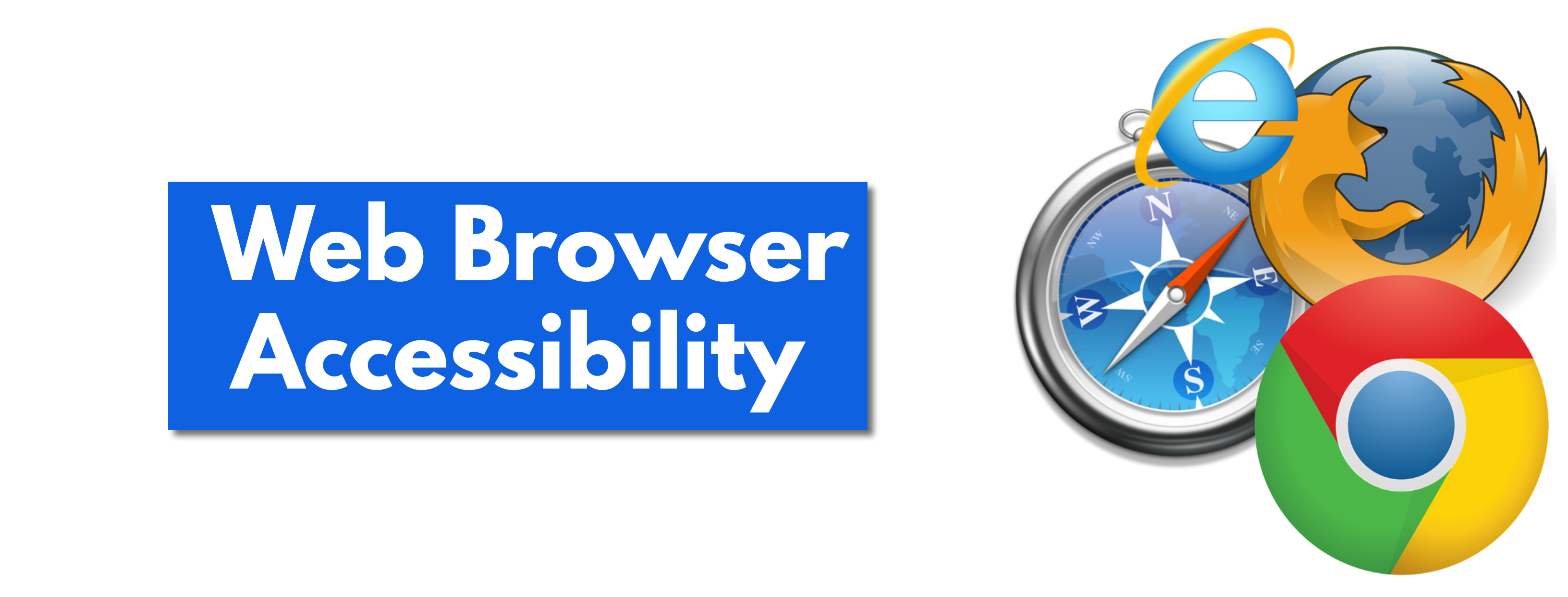Creating an Inclusive Web Experience: A Comprehensive Guide to Web Browser Accessibility

In the United States alone, approximately 25% of adults have some form of disability that impacts their use of the web. As we rely more on the internet for everything from work to socializing, ensuring that the web is accessible to all users becomes increasingly important. So, what exactly is web browser accessibility, and how can we ensure that everyone has equal access to online content?
Before we explore web browser accessibility and what it means, let’s take a look at what a web browser is.
A web browser is a software application that allows users to access and view information on the World Wide Web. It is a tool that retrieves and displays content from websites and other online resources.
Some popular web browsers include Google Chrome, Mozilla Firefox, Apple Safari, Microsoft Edge, and Opera. Each browser may have different features and capabilities, but all serve the same purpose of providing users with access to the vast amount of information available on the internet.
👉 Does Your Website Comply with ADA Standards?
What is Web Browser Accessibility?
Web browser accessibility refers to the design of websites that everyone can use, regardless of their abilities or disabilities. It involves designing websites that are easy to navigate, with clear and concise labeling, intuitive layouts, and alternative ways to access content, such as captions for videos and audio descriptions for images.
In addition, accessible websites are optimized for assistive technologies, such as screen readers and speech recognition software, which can help people with disabilities access and interact with content more easily.
By creating accessible websites, organizations can ensure that they are not excluding a large portion of the population from their content and services.
Web Browser Accessibility Features
Web browser accessibility features are a crucial aspect of web design and development. They are tools and options built into web browsers that enable users with disabilities to access online content. These features remove barriers to access and provide a more inclusive browsing experience for everyone. These are some essential web browser accessibility features:
- Screen Readers: These are built into the most popular web browsers and read out the content of a webpage to users who are blind or have low vision. They use a programmed voice to read out the text on the page.
- High-contrast mode: This changes the color scheme of a webpage to provide better visibility for users with low vision or color blindness. The feature increases the contrast between text and background, making it easier for users to read and navigate web pages.
- Zooming: This feature helps users magnify web content, making it easier to read and navigate. Zooming is particularly useful for users with low vision or those who have difficulty reading small text.
- Closed Captions/Subtitles: Closed captions or subtitles are a vital web browser accessibility feature for people who are deaf or hard of hearing. They provide a text-based version of the audio content in a video or audio file, enabling users to follow along with the content. Many web browsers have built-in closed captioning options for videos, and there are third-party plugins that can add closed captions to online content.
- Readability Enhancements: These are another web browser accessibility feature that can improve the readability of online content. These enhancements typically include options to adjust the font type, size, and spacing of web content to make it easier to read. Some web browsers also offer the ability to change the background color of a webpage to reduce eye strain and improve readability.
In addition to these built-in accessibility features, many web browsers offer extensions and add-ons that can enhance accessibility. Text-to-speech plugins, for example, enable users to listen to web content rather than read it. Font enlargement tools allow users to increase the font size used on a webpage, making it easier to read.
Best Web Browser Accessibility Test Plugins
When it comes to testing for web accessibility, test plugins are an essential tool for web developers and designers. These plugins help to identify potential accessibility barriers and ensure that websites are usable by all users, including those with disabilities. Check out some of the most popular test plugins:
- Accessibility Insights for Web: Created by Microsoft, this plugin provides a comprehensive set of tools for testing web accessibility, including automated tests for common issues such as missing alternative text, low contrast, and improper heading structure. Accessibility Insights for Web also provides manual testing tools, which allow developers and designers to test for more complex accessibility issues that cannot be detected automatically.
- WAVE Evaluation Tool: This test plugin is available as a browser extension for Google Chrome and Mozilla Firefox. The WAVE Evaluation Tool checks web pages for accessibility issues and provides a visual representation of the page’s accessibility. It highlights potential problems such as missing alternative text, contrast errors, and improper heading structure.
- AChecker: This tool checks web pages for accessibility issues based on international accessibility guidelines, including the Web Content Accessibility Guidelines (WCAG) 2.0 and 2.1. AChecker provides a detailed report of accessibility issues and recommendations for fixing them.
What Are the Top 5 Web Accessibility Audit Tools?
Web Browsers Ranked for Accessibility Features

One of the most well-known organizations that rank web browsers for accessibility is WebAIM, a non-profit organization dedicated to promoting web accessibility. WebAIM’s 2018 web browser survey evaluates the accessibility features of several popular web browsers based on criteria such as keyboard accessibility, screen reader compatibility, and support for assistive technologies.
According to the latest WebAIM survey, the top-ranked web browsers for accessibility features are Google Chrome, Mozilla Firefox, and Apple Safari. These web browsers scored high in several categories, including keyboard accessibility, compatibility with screen readers, and support for accessibility APIs. Google Chrome, in particular, scored high in the survey due to its robust support for accessibility features and its integration with Google’s suite of accessibility tools.
Other popular web browsers, such as Microsoft Edge and Opera, also scored well in the survey but fell short in certain categories like keyboard accessibility and compatibility with screen readers. However, it is crucial to note that the accessibility features of web browsers can vary depending on the operating system and assistive technology being used.
In conclusion, web browser accessibility is an essential aspect of web design and development that must be taken seriously. By implementing web browser accessibility features, testing for accessibility, and balancing security and accessibility, we can ensure everyone has equal access to online information. With the growing number of people with disabilities worldwide, it is more important than ever to prioritize accessibility in web design and development.
If you found this article helpful, please consider sharing it with others who might benefit from this information. Sharing is caring!
Leave a Reply